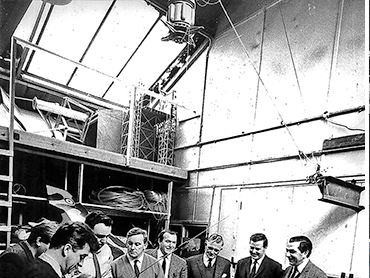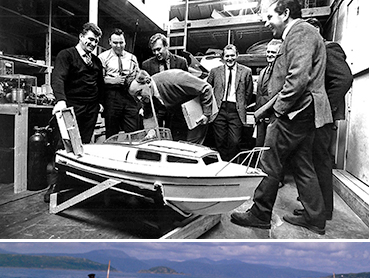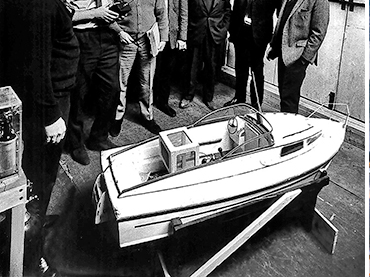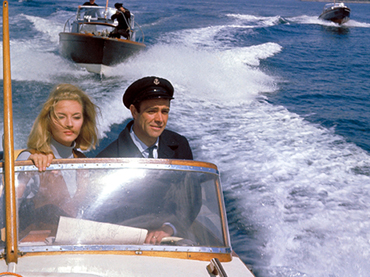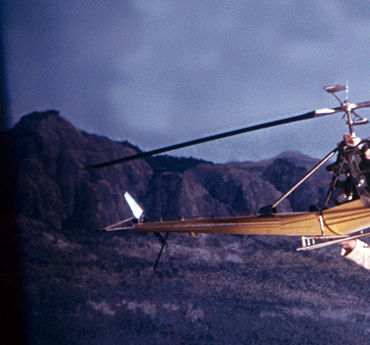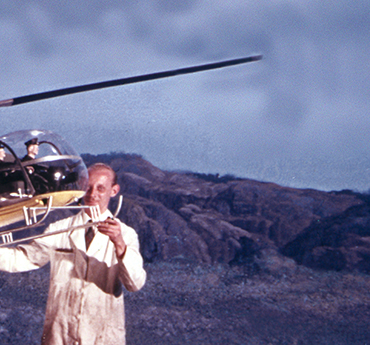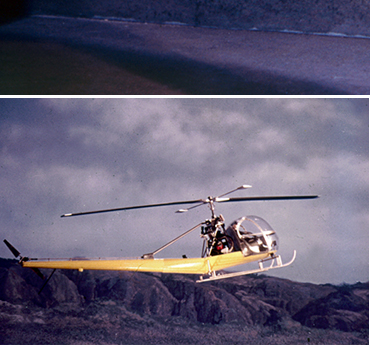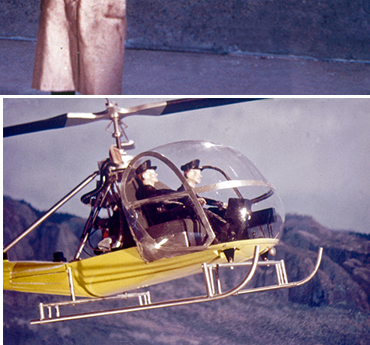|
 |
From the Archive
007 Issue #13 (1983) |
|
|
|
|
 |
|
One of the many
memorable sequences in From Russia With Love (1963) was Krilencu’s
attack on the gypsy camp, shot on the waste ground in front of the Paddock
Tank at Pinewood. When you are faced with such complex action shots, knife
throwing, fights and explosions – how do you go about preparing for the
shot? Do you follow a set pattern?
This is the whole thing about the Bond pictures. This is the reason I
think why the first ones were so successful. In the early days there was a
terrific feeling, everybody was involved with the project; you had a
working script, yes, but every time a certain situation arose, Harry and
‘Cubby’ would come to me and say – ‘look, if you were in this situation what
would you do from a practical point of view?’ – and I would work out a
format. That’s how it used to be. With
Terence Young you were involved
24-hours a day seven days a week, and that was the difference between
those pictures and the ones they are making today. Although the budgets
weren’t as big, those films were very well put together, there seemed to
be a lot of planning and preparation in each shot, which I don’t think is
true today.
There doesn’t seem to be the same kind of care taken.
There’s not. You’re absolutely right, but the real thing that’s wrong is
that they haven’t got any heart, they are just going for one spectacular
sequence after another, which without a story or reason doesn’t mean a
damn thing!
Hopefully Sean Connery’s new Bond picture (Never Say Never Again)
will rectify those problems.
Well of course, ‘Cubby’ will never be successful without
Harry Saltzman in
that respect because although Harry has left the set up now – he was the
ideas man. We used to have terrific fights. ‘Cubby’ and Harry used to have
fights but Harry was the instigator and ‘Cubby’ was the leveller, and I’m
afraid all you have now is ‘Cubby’, a very nice sweet guy, and he just
listens to a few people, and relies on the experience they have had in the
past making Bond pictures – and that’s where the whole thing falls down.
Things were well prepared in the old ones. There were lots of fights but
it was all good fun. You found out what each person was thinking and the
Director was there and he threw his oar in as well and we used to sit
round a table and fight it out, and that’s how the pictures were made, but
it doesn’t happen now. |
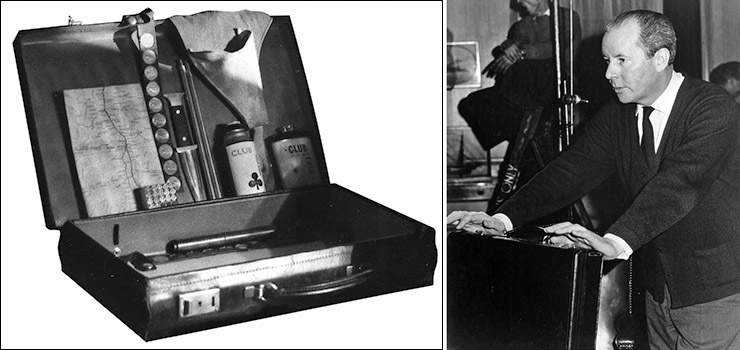 |
|
ABOVE: (left) James Bond's deadly briefcase provided by Q Branch
in From Russia With Love (1963) - in reality devised by
Special Effects maestro John Stears and his team. (right) Director
Terence Young demonstrates how Bond should open the briefcase
to avoid it exploding during rehearsals at Pinewood Studios. |
|
|
|
From Russia With
Love was really the first film in the series to introduce gadgets,
although they were fairly sensible in those days, unlike those used in the
films now.
That’s what I was saying, they would come to me as ideas man and say ‘what
would you need to get out of a situation like this’, and I’d make
something, and prove to them in theory that it could work.
So it was never a
question of the producers or director coming to you and saying ‘we need a
briefcase with lots of extras like knives etc. can you make one?’ They
actually came to you and asked how you would get Bond out of a certain
situation and you then dreamt up the idea.
Exactly, yes. |
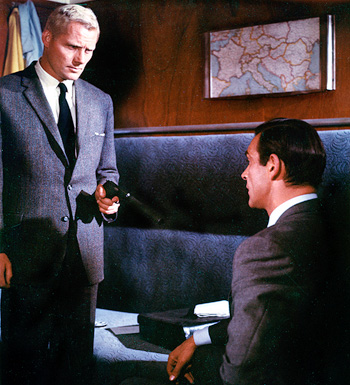 |
I gather all the
gadgets in the briefcase worked?
Yes, all the items in the case worked.
You used a talcum powder cartridge to act as teargas?
Yes, fired under pressure.
Apart from the
briefcase, were SFX utilised in any other part of the train fight
between Bond and Grant on board the Orient Express?
Oh yes, we were involved with breakaway sets and with the stunt team.
In fact, we were totally involved. Even with the wardrobe and makeup
you were still involved, all the way through.
Another difference between the old and new films is the fight
scenes. The train fight in The Spy Who Loved Me (1977) can’t
compare to the ‘dust up’ in From Russia With Love (which was a
marvellous piece of fight choreography) because it’s too slow.
Well of course, you had a brilliant editor in the early days called
Peter Hunt. Although
John Glen is a superb editor, he was working with
Peter Hunt, and I think John would be the first to admit that he
learned a lot from Peter. |
|
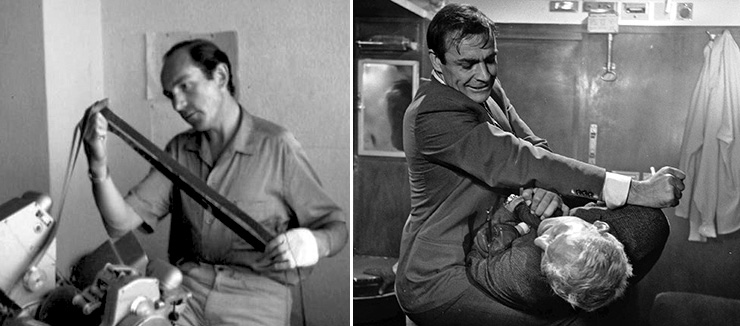 |
|
ABOVE: (left) Peter
Hunt at work in the editing room where his innovative cutting
style defined the pace of the first five James Bond films on which he
worked, before making his directing debut with On Her Majesty's
Secret Service (1969). Hunt's signature style is perfectly
showcased in the brutal fight (right) between James Bond (Sean
Connery) and Donald Grant (Robert Shaw) [doubled in some shots by
Peter Perkins and Jackie Cooper] on board the Orient Express in
From Russia With Love (1963). |
|
|
|
Yes, I think that was
the greatest asset in On Her Majesty’s Secret Service (1969). The
editing kept it alive, and I think it’s fair to say that this film is
generally acknowledged among Bond fans to be one of the best in the
series.
Yes. I think technically and artistically that it was one of the best
films. |
|
|
|
ABOVE: (left) John Stears shows off a
radio-controlled model of a Fairey Huntress motor boat to
colleagues at Pinewood Studios. Among the technicians in the
photograph are Joe Fitt (far left), Peter Lamont (centre), set
Construction Manager Ronnie Udell, and
Production Designer Ken Adam (far right), who was then working on
Dr. Strangelove (1964) for director Stanley Kubrick at
Shepperton Studios. (below right) Sean Connery [with Daniela
Bianchi as Tatiana Romanova] pilots the full-size Fairey Huntress
on location at
Crinan Harbour in
Scotland for the climactic boat chase in From Russia With Love
(1963).
BELOW: Filming of the climax of the boat chase took place in the
Paddock Tank at Pinewood Studios, with stunt arranger Peter
Perkins doubling Walter Gotell (as Morzeny) as he meets his fiery
demise. |
|
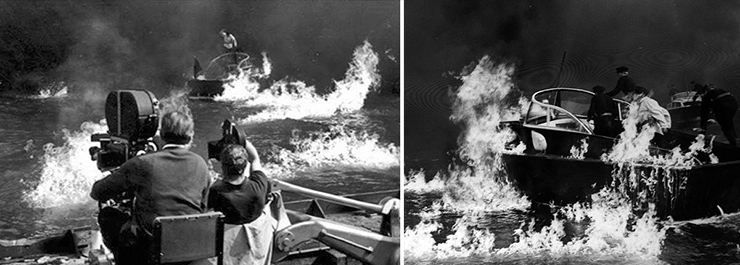 |
|
|
One sequence in
From Russia With Love that looked particularly dangerous was the boat
chase. There’s a scene where two of the boats collide head on, and a
stuntman leaps into the water with his clothing on fire. I gather that got
a little out of hand during filming?
No, no. Nothing has ever gotten out of hand on a Bond film I’ve done. We
never had an accident, it was just well acted. All the guys were prepared,
nobody got burnt. It took about a week to shoot, I think. The only time
somebody got singed was when (stunt arranger)
Peter Perkins was supposed
to have swum underwater and he came up too soon in the middle of the
flames – but he was all right. |
|
|
|
ABOVE (top) Special
Effects technician Bert Luxford with the miniature
helicopter seen in From Russia With Love (1963). The model
was filmed against a photographic blow-up of the Scottish
landscape,
also used as a plate for the back-projection shots of the
exploding helicopter after Bond shoots it down. The close-up
detail (bottom right) shows two carved wooden figures as the
SPECTRE henchmen. |
|
|
|
You also worked on the helicopter chase where Bond shoots the pilot.
Was a radio-controlled helicopter used during this sequence?
Ah! I’m glad you asked me that, because no it wasn’t! It was the first
model helicopter that had been used in the film industry. I had a little
27cc motor in that, and we put just enough pitch on the rotors to keep it
stable and then tethered it so that it just went up on its own.
Filming a sequence on the scale of the boat chase and with
unpredictable elements like fire and water, what kind of precautions can
you take to ensure nothing goes wrong?
With fire your biggest problem is change of wind direction. You rehearse
the action and make sure people are in the right place at the right time,
but you’ve always got the problem of a stuntman slipping or falling, so
you’ve got to get him clear quickly if necessary. But that’s stunt work,
and it’s what stuntmen get paid for. Stunt work is a dangerous hazardous
job! They get extremely well paid for it and they do a superb job. |
|
CONTINUED |
|





